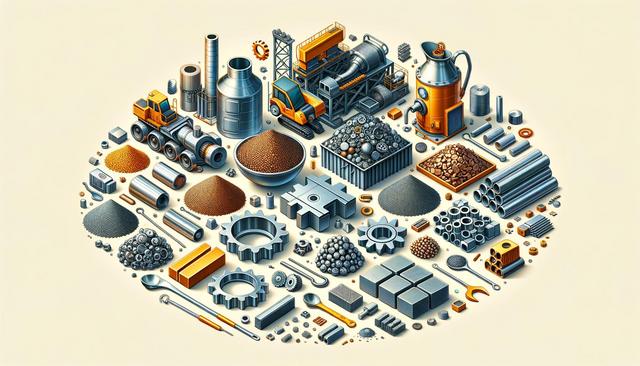Wrought Iron: Characteristics and Historical Relevance
Wrought iron is one of the earliest forms of iron used in human history and was widely employed before the advent of steelmaking processes. Characterized by its fibrous structure and low carbon content (typically less than 0.08%), wrought iron is known for its ductility, malleability, and resistance to corrosion. In traditional metallurgy, it was produced through a labor-intensive process involving the heating and hammering of pig iron to remove impurities. While its use has diminished in modern industrial applications, wrought iron remains relevant in historical restoration projects and decorative metalwork due to its aesthetic appeal and workability. Common applications include:
- Fencing and gates
- Architectural detailing
- Antique furniture
- Restoration of historical buildings
Its ability to withstand weathering without significant degradation made it a preferred choice in outdoor structures before the development of more advanced iron alloys.
Cast Iron: High Carbon Content and Industrial Utility
Cast iron, distinguished by its high carbon content (ranging from 2% to 4%), is widely used in industries that require materials with excellent compressive strength. Due to its brittleness, cast iron is not suitable for tensile applications, but it excels in applications where rigidity and durability are essential. The casting process allows for complex shapes and intricate designs, making it highly adaptable for manufacturing. Types of cast iron include:
- Gray iron – known for its good machinability and vibration damping
- White iron – hard and wear-resistant but very brittle
- Ductile iron – enhanced with magnesium to improve flexibility
- Malleable iron – heat-treated to increase toughness
Industrially, cast iron is used in engine blocks, machinery bases, pipes, cookware, and construction components like manhole covers. Its affordability and resistance to deformation under load make it a staple in heavy manufacturing and infrastructure.
Steel: The Most Versatile Iron Alloy
Steel is not a pure form of iron but an alloy of iron and carbon, often enriched with other elements such as chromium, nickel, manganese, and vanadium to enhance its properties. The carbon content in steel can vary from 0.1% to 1.5%, significantly influencing its strength, ductility, and hardness. Steel is the backbone of modern construction and manufacturing due to its versatility and ability to be tailored for specific applications. Major types of steel include:
- Carbon steel – widely used in construction and tools
- Alloy steel – used in pipelines, automotive components, and aerospace
- Stainless steel – corrosion-resistant and used in medical instruments and kitchenware
- Tool steel – hardened for making cutting and forming tools
From skyscrapers and bridges to automobiles and appliances, steel plays a foundational role in shaping the built environment. Its strength-to-weight ratio and recyclability further enhance its industrial appeal.
Pig Iron: The Starting Point in Iron Processing
Pig iron is the intermediate product obtained from the smelting of iron ore with a high-carbon fuel such as coke, typically in a blast furnace. It contains a high percentage of carbon (often over 4%) along with silicon, manganese, sulfur, and phosphorus. Pig iron itself is too brittle for direct use in most applications, but it serves as the critical raw material for the production of both cast iron and steel. Its industrial significance lies in its role as a precursor material, which can be processed further into more refined and usable forms of iron and steel. Applications include:
- Feedstock for steelmaking in basic oxygen furnaces
- Raw material for foundries producing cast iron components
- Occasional use in steel mills for alloy formulation
By acting as a bridge between raw ore and finished metal products, pig iron supports the continuity and efficiency of the iron and steel industry.
Powdered Iron and Specialized Applications
Powdered iron, also known as iron powder, is used in a variety of specialized applications where traditional forms of iron are not suitable. This form is produced through atomization, reduction, or electrolysis of purified iron. Its fine granular structure allows for precise control in manufacturing processes such as powder metallurgy, where components are formed by compressing and sintering iron powder. Notable uses include:
- Magnetic cores in electronics
- Friction materials in automotive braking systems
- Structural parts in machinery through powder metallurgy
- Metallic paints and coatings
Powdered iron is also employed in chemical applications, such as water treatment and as a reducing agent in various industrial processes. Its adaptability to form complex shapes with minimal waste makes it an efficient and sustainable choice in modern manufacturing.
Conclusion: The Industrial Importance of Iron Variants
Understanding the different types of iron used in metallurgy is essential for professionals across construction, manufacturing, and engineering sectors. Each form of iron—whether wrought, cast, steel, pig, or powdered—offers unique properties that make it suitable for specific industrial applications. By selecting the appropriate type of iron, industries can optimize performance, durability, and cost-efficiency in their products and infrastructure. As technology advances, the role of iron in industrial processes continues to evolve, reinforcing its significance as a cornerstone of modern development.




Leave a Reply